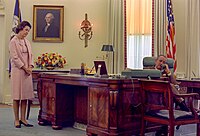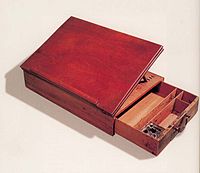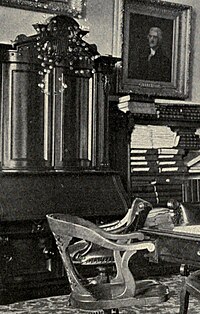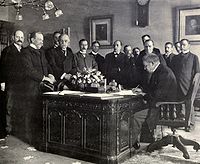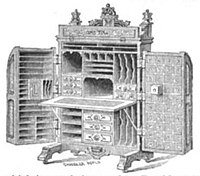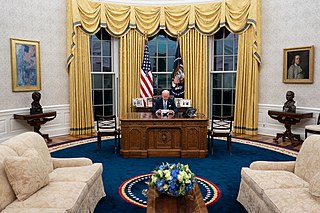
The Oval Office is the formal working space of the president of the United States. Part of the Executive Office of the President of the United States, it is in the West Wing of the White House, in Washington, D.C.

The White House Rose Garden is a garden bordering the Oval Office and the West Wing of the White House in Washington, D.C., United States. The garden is approximately 125 feet long and 60 feet wide. It balances the Jacqueline Kennedy Garden on the east side of the White House Complex. It is commonly used as a stage for receptions and media events due to its proximity to the White House.

Most United States presidents have kept pets while in office, or pets have been part of their families. Only James K. Polk, Andrew Johnson, and Donald Trump did not have any presidential pets while in office. However, Johnson did take care of some mice he found in his bedroom.
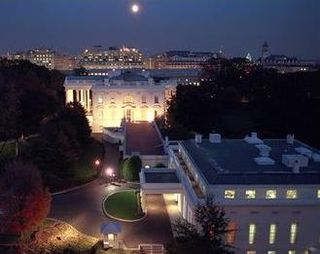
The West Wing of the White House houses the offices of the president of the United States. The West Wing contains the Oval Office, the Cabinet Room, the Situation Room, and the Roosevelt Room.

The Resolute desk, also known as the Hayes desk, is a nineteenth-century partners desk used by several presidents of the United States in the White House as the Oval Office desk, including the five most recent presidents. The desk was a gift from Queen Victoria to President Rutherford B. Hayes in 1880 and was built from the oak timbers of the British Arctic exploration ship HMS Resolute. The 1,300-pound (590-kilogram) desk was created by William Evenden, a skilled joiner at Chatham Dockyard in Kent, probably from a design by Morant, Boyd, & Blanford. The desk has been modified twice, with a kneehole panel added in 1945 and a 2-inch-tall (5.1 cm) plinth added to the desk in 1961.

The White House Library is a room in the White House, the official home of the president of the United States. The room is approximately 27 by 23 feet and is in the northeast corner of the ground floor. The library is used for teas and meetings hosted by the president and first lady. During the 1950s reconstruction of the White House, old building lumber from the house was salvaged and re-made into wall paneling for this room. Several basement rooms in the White House are paneled with salvaged building materials from the pre-reconstructed White House.

The Yellow Oval Room is an oval room located on the south side of the second floor in the White House, the official residence of the president of the United States. First used as a drawing room in the John Adams administration, it has been used as a library, office, and family parlor. It was designated the Yellow Oval Room during the restoration overseen by First Lady Jacqueline Kennedy. Today the Yellow Oval Room is used for small receptions and for greeting heads of state immediately before a State Dinner.

The Treaty Room is located on the second floor of the White House, the official residence of the president of the United States. The room is a part of the first family's private apartments and is used as a study by the president.

The Family Dining Room is a dining room located on the State Floor of the White House, the official residence of the president of the United States. The room is used for smaller, more private meals than those served in the State Dining Room. Used in the 1800s as a space for the First Family to have their meals, the Family Dining Room was used less for family meals and more for working lunches and small dinners in the 20th and 21st centuries.

The Executive Residence is the central building of the White House complex located between the East Wing and West Wing. It is the most recognizable part of the complex, being the actual "house" part of the White House. This central building, first constructed from 1792 to 1800, is home to the president of the United States and the first family. The Executive Residence primarily occupies four floors: the ground floor, the state floor, the second floor, and the third floor. A sub-basement with a mezzanine, created during the 1948–1952 Truman reconstruction, is used for HVAC and mechanical systems, storage, and service areas.

The Roosevelt Room is a meeting room in the West Wing of the White House, the home and main workplace of the president of the United States. Located in the center of the wing, near the Oval Office, it is named after two related U.S. presidents, Theodore Roosevelt and Franklin D. Roosevelt, who contributed to the wing's design.
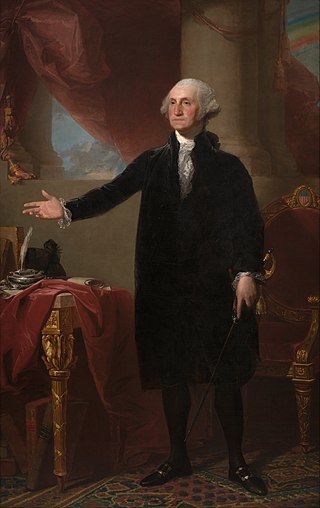
Beginning with painter Gilbert Stuart's portrait of George Washington, it has been tradition for the president of the United States to have an official portrait taken during their time in office, most commonly an oil painting. This tradition has continued to modern times, although since the adoption of photography as a widely used and reliable technology, the official portrait may also be a photograph.
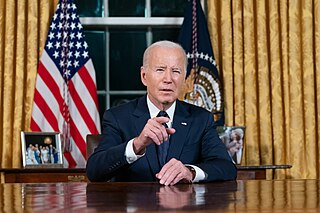
An address to the nation is a type of speech made from a head of state or head of government. It is considered among the most solemn settings for an address made by a leader, and is most often delivered to announce a major new policy initiative, on the occasion of a leader's departure from office, or during times of national emergency.

The desk in the Vice President's Room of the United States Capitol, colloquially known as the Wilson desk and previously called the McKinley-Barkley desk, is a large mahogany partner's desk used by U.S. Presidents Richard Nixon and Gerald Ford in the Oval Office as their Oval Office desk. One of only six desks used by a President in the Oval Office, it was purchased in 1898 by Garret Augustus Hobart, the 24th Vice President of the United States, for the Vice President's Room in the United States Capitol.
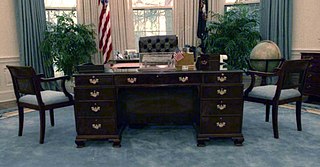
The C&O desk is one of six desks ever used in the Oval Office by a sitting President of the United States. The C&O Desk was used in the executive office by only George H. W. Bush, making it one of two Oval Office desks to be used by only one president there. Prior to its use in the Oval Office by Bush, the desk had been in use elsewhere in the White House. It is the shortest-serving Oval Office desk to date, having been used for one four-year term.
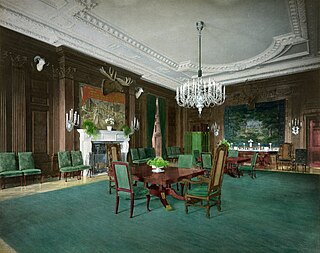
A. H. Davenport and Company was a late 19th-century, early 20th-century American furniture manufacturer, cabinetmaker, and interior decoration firm. Based in Cambridge, Massachusetts, it sold luxury items at its showrooms in Boston and New York City, and produced furniture and interiors for many notable buildings, including The White House. The word "davenport," meaning a boxy sofa or sleeper-sofa, comes from the company.

The desk in the Vice President's Ceremonial Office in the Eisenhower Executive Office Building, colloquially known as the Theodore Roosevelt desk, is a large mahogany pedestal desk in the collection of the White House. It is the first of six desks that have been used by U.S. presidents in the Oval Office, and since 1961 has been the used as the desk of the U.S. Vice President.

The Hoover desk, also known colloquially as FDR's Oval Office desk, is a large block front desk, used by Presidents Herbert Hoover and Franklin D. Roosevelt in the Oval Office. Created in 1930 as a part of a 17-piece office suite by furniture makers from Grand Rapids, Michigan, the Art Deco desk was given to the White House by the Grand Rapids Furniture Manufacturers Association during the Hoover administration. The desk was designed by J. Stuart Clingman, and was built by the Robert W. Irwin Company from American lumber and faced with Michigan-grown maple burl wood veneer. After Roosevelt's sudden death in 1945, Harry S. Truman removed the desk from the Oval Office and gave it to Roosevelt's wife, Eleanor Roosevelt. She displayed it at, and later donated it to, the Franklin D. Roosevelt Presidential Library and Museum in Hyde Park, New York. The desk has been on display there ever since. The Hoover desk is one of only six desks to be used by a president in the Oval Office.

The Johnson desk is a mahogany partners desk that was used by U.S. President Lyndon B. Johnson in the Oval Office as his Oval Office desk. One of only six desks used by a president in the Oval Office, it was designed by Thomas D. Wadelton and built in 1909 by S. Karpen and Bros. in Chicago. The desk was built as part of 125 seven-piece office sets for senators' offices in the Russell Senate Office Building, and was used by Johnson during his terms as U.S. Senator, Vice President, and President. It is currently located at Lyndon Baines Johnson Library and Museum as part of a replica Oval Office.

Some presidents of the United States have had a red call button in the Oval Office of the White House that could call aides. The earliest incarnation dates to 1881 or before, and the modern call button has been in a wooden box on the Resolute desk since at least the George W. Bush presidency (2001–2009).






